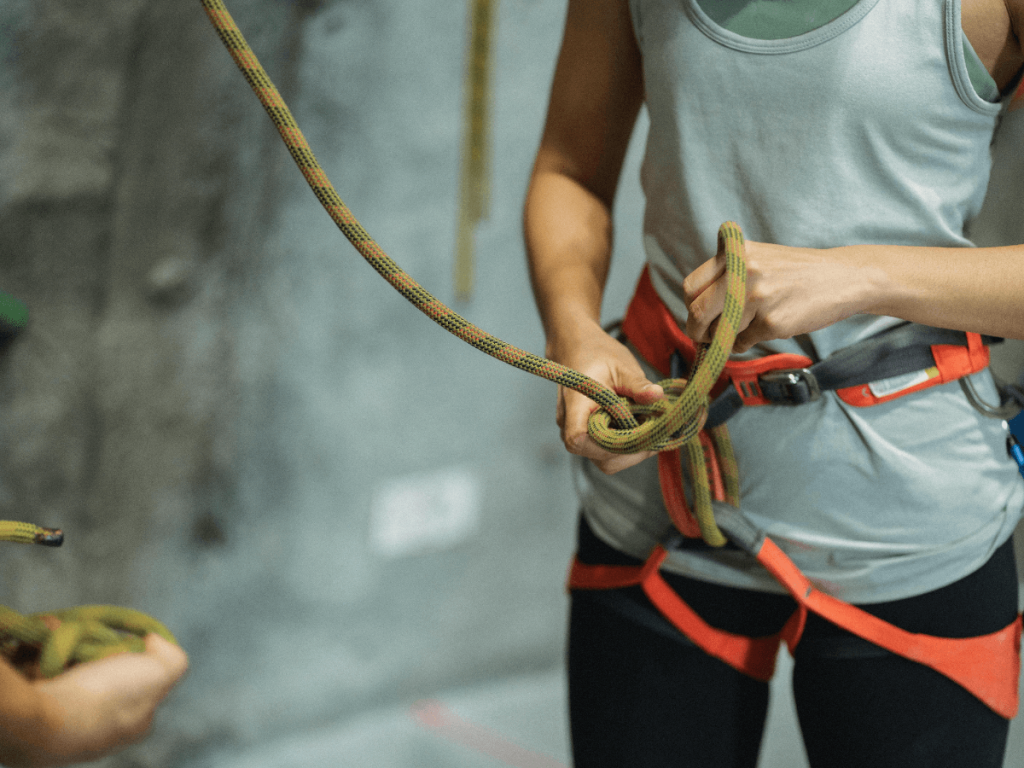A rock climbing harness is not just a piece of gear; it’s your gateway to thrilling adventures. You’ll experience the exhilaration of taking falls, the freedom of hanging from the rope, and the comfort of wearing it around the crag or gym. So, choose a harness that suits your climbing style and ignites your passion for this incredible sport.
The two main types of rock climbing harnesses are sit and full-body. Sit harnesses have waist and leg loops, while full-body harnesses have loops for your arms. The most commonly used harness is a sit harness. Children or pregnant women usually use full-body harnesses. And yes! Just because you’re pregnant doesn’t mean you must stop climbing!
What to Consider When Choosing a Rock Climbing Harness

When choosing a harness for the first time, the most important thing to consider is what kind of climbing you plan to do with it. Will you be primarily top roping in the gym or planning some multi-pitch alpine climbs? Maybe you’re just looking for something to take sport climbing at your local crag!
If you only plan to go single-pitch sport climbing, you don’t need a harness with ice-axe loops, a haul loop, or even a double set of gear loops. Check out below for some other things to consider when choosing a rock climbing harness:
Safety First: Rock climbing is never “safe.” So when it comes to your climbing gear, there’s no compromise. Look for harnesses certified by esteemed safety standards like the UIAA (International Mountaineering and Climbing Federation) or CE (European Conformity). These certifications ensure the harness meets stringent safety requirements, such as strength, durability, and resistance to wear and tear. This gives you the confidence to push your limits, knowing that your harness is designed and tested to keep you safe in the most challenging climbing conditions.
Purchase from Reputable Retailers: There are some products where quality matters less. Paper towels? Go ahead and buy the cheapest ones on Amazon! But for harnesses, you want to be sure to always purchase from a reputable outdoor retailer. Your local gym is a great place to start. If they do not have the harness you are looking for in stock, they can help point you in the right direction. Don’t take your chances with an off-brand harness.
Optimal Fit and Comfort: The key to an enjoyable climbing experience is a harness that fits perfectly and grants unrestricted movement. Experiment with various harnesses until you discover one that fits snugly without causing discomfort or any constriction. Remember that some harnesses have adjustable leg loops, while others are fixed at a specific diameter.
Gear Loops: Gear loops are your reliable partners for carrying climbing equipment such as carabiners, quickdraws, belay devices, and anchor-building material—everything you need for a successful climbing day. The number and placement of gear loops should be considered based on your climbing style and the gear you typically carry. If you plan to tackle some big wall climbing (routes that can take days), investing in a harness with a haul loop is a wise choice! The placement of gear loops is also crucial. They should be easily accessible and not interfere with your climbing movements, ensuring a smooth and efficient climbing experience.
Foam Considerations: There are two main types of foam used in climbing harnesses.
- EPE (expanded polyethylene) foam is standard and inexpensive, which makes it the most used type of foam in climbing harnesses. It can be made from partially or fully recycled material. Think of items like packing materials or pool noodles; this is EPE foam. Its open-cell construction makes it lightweight and spongey.
- EVA (ethylene-vinyl acetate) foam is much denser and more durable than EPE foam. Its density makes it stiffer, which allows it to be trimmed and molded into different shapes more easily. Think of a pair of flip-flops. You’ll typically find this foam on more high-end harnesses because it can absorb more impact than EPE foam.
Weight and Packability: If you aspire to do multi-pitch or alpine climbing, factoring in the weight and packability of your harness can help save some weight in your pack. Packability refers to how easily the harness can be folded or compressed for storage or transport. Lightweight and compact harnesses are ideal for these activities because they keep your weight down and can fold easily, allowing you to carry them in your backpack without taking up too much space.
Budget Considerations: While it’s crucial to establish a budget for your harness, remember that investing in your safety should take precedence. Wallet-friendly options are available, but quality, durability, and safety features are prioritized over price. Buying the proper gear can save your life and give you peace of mind when climbing. It’s better to spend a little more on a high-quality harness that meets your safety needs than to risk your safety with a cheaper, less reliable option.
Test For Fit: Whenever possible, try on various harnesses before making your final decision. A visit to a local gear shop or climbing gym can allow you to check out their offerings. This hands-on approach lets you assess the fit, comfort, and features firsthand. When testing a harness, make sure the waist belt sits snugly above your hips, the leg loops are comfortable and not too tight, and the harness does not restrict your movement. Don’t hesitate to seek guidance from knowledgeable staff who can offer valuable advice to help you make an informed choice.
Thinking of The Future: Although your focus may be on indoor gym climbing, it’s wise to consider a harness to accommodate your future endeavors. These could include outdoor sport climbing, multi-pitch climbing, or even alpine climbing. If you plan to stick with climbing in the gym, there’s no need to look further. But opting for a versatile harness capable of adapting to a range of climbing styles will save you the trouble of purchasing a new one soon after.
Personal Preferences Matter: Selecting a rock climbing journey is unique, as are your preferences. Whether you prioritize lightweight designs or maximum comfort, your choice of a rock climbing harness reflects your individuality. So, consider your needs and priorities, and choose a harness that aligns with your style and climbing goals.

Recent Comments